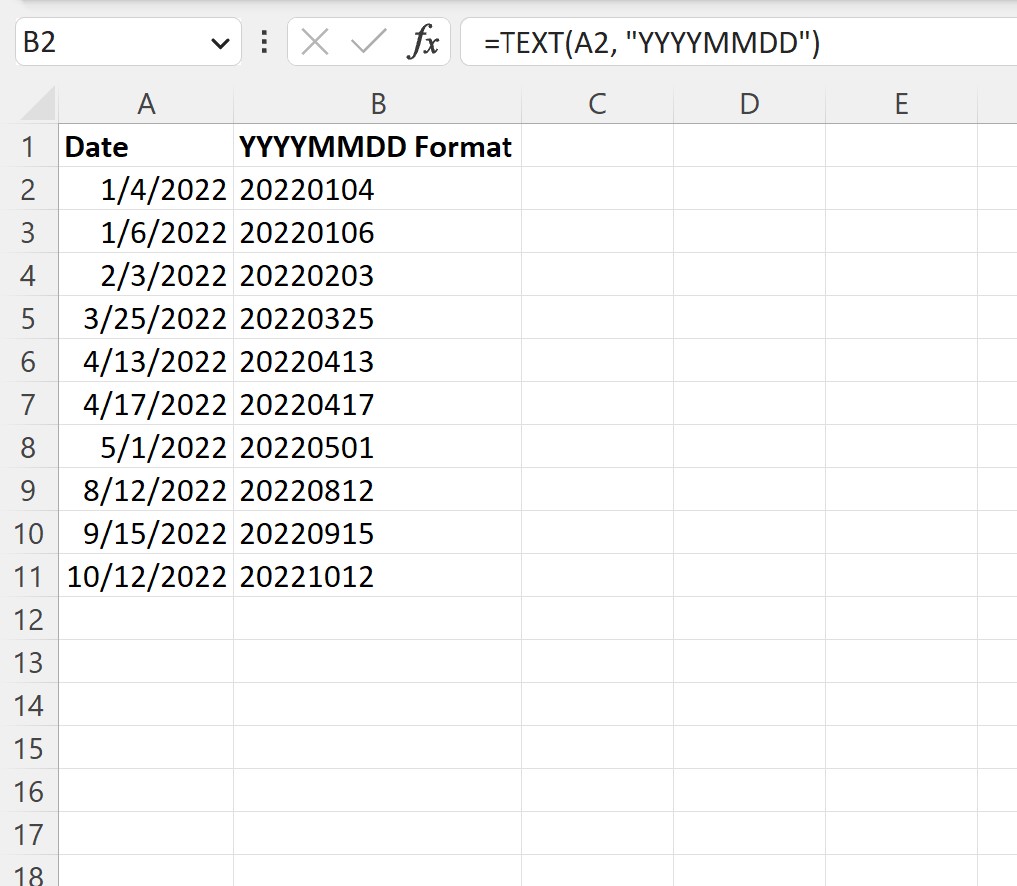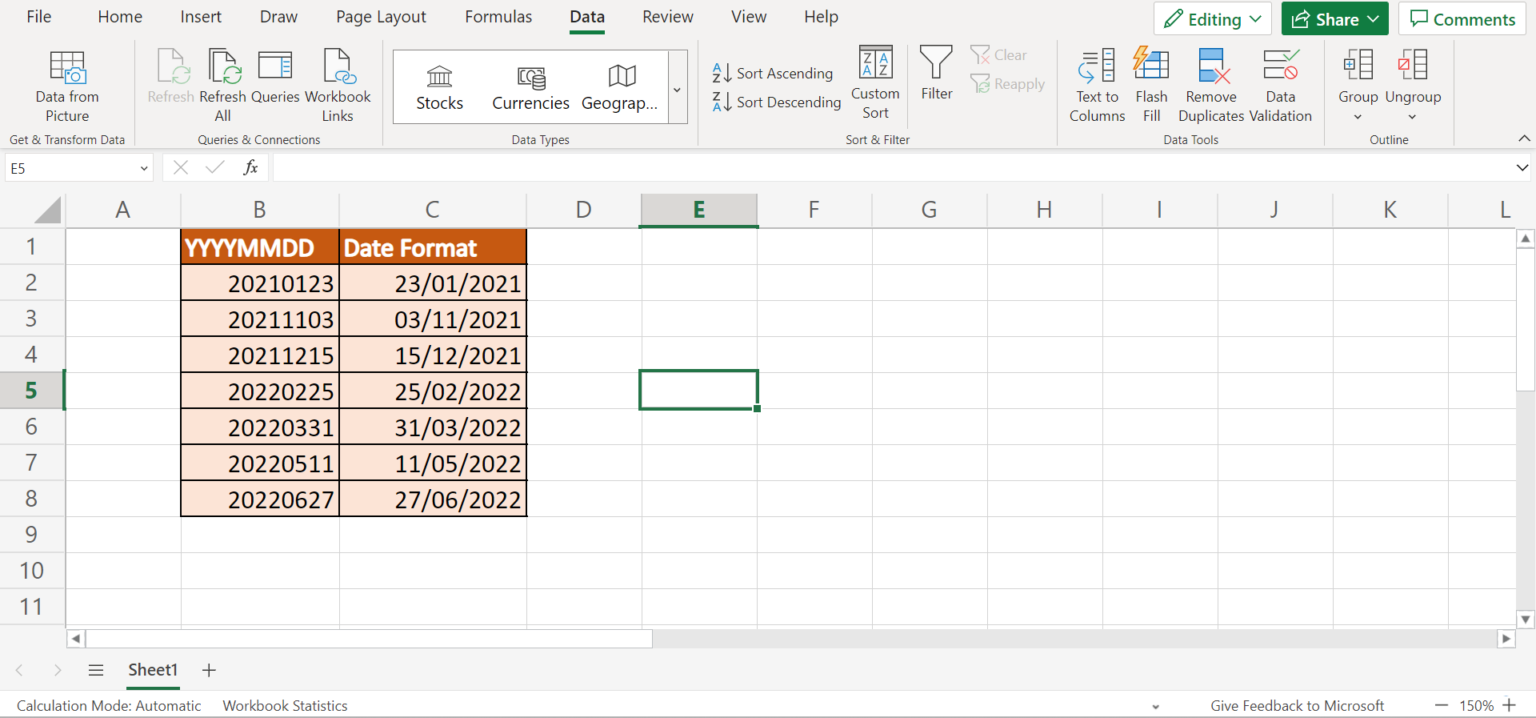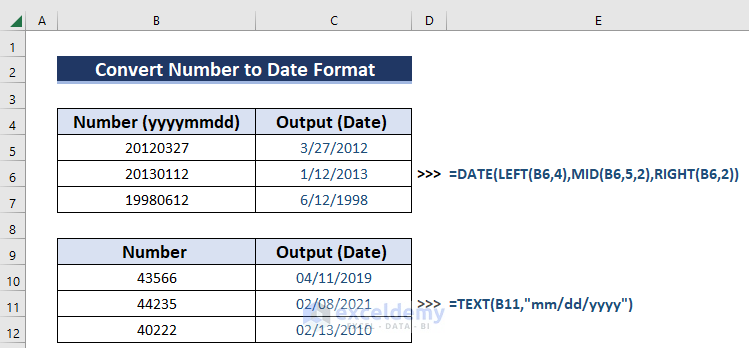How to Master the yyyymmdd to Date Excel Function

The yyyymmdd to Date function in Excel is a powerful tool for manipulating and converting date formats. This article aims to guide you through the intricacies of this function, offering a comprehensive understanding and practical insights to help you master date conversions with ease. Let's delve into the world of date formatting in Excel and explore the best practices for using this essential function.
Understanding the yyyymmdd to Date Function

The yyyymmdd to Date function is a custom formula in Excel that allows users to convert a date represented in the yyyymmdd format (e.g., 20230514) into a standard date format (e.g., 14-May-2023). This function is particularly useful when dealing with data that originates from systems or sources that use the yyyymmdd format, making it an indispensable tool for data analysts, researchers, and professionals working with large datasets.
By mastering this function, you can streamline your data cleaning and formatting processes, ensuring that your date-related calculations and analyses are accurate and efficient. Let's explore the steps and considerations involved in utilizing this function effectively.
Step 1: Identifying the yyyymmdd Format
The first step in using the yyyymmdd to Date function is to correctly identify and understand the yyyymmdd format. In this format, the date is represented by a string of digits, where the first four digits represent the year, the next two represent the month, and the last two represent the day. For example, the date 20230514 would translate to May 14, 2023 in the standard date format.
| yyyymmdd | Standard Date |
|---|---|
| 20230514 | May 14, 2023 |
| 20221231 | December 31, 2022 |
| 20210101 | January 1, 2021 |

Step 2: Constructing the Formula
The yyyymmdd to Date function is a custom formula that you can create in Excel. Here’s how to construct it:
- Open your Excel workbook and navigate to the cell where you want the converted date to appear.
- Type the following formula: =DATE(LEFT(A1,4),MID(A1,5,2),RIGHT(A1,2)), replacing A1 with the cell reference containing the yyyymmdd date.
- Press Enter to execute the formula, and the cell will display the converted date in the standard format.
Let's break down the formula:
- DATE(year, month, day): This is an Excel function that constructs a date from the specified year, month, and day values.
- LEFT(text, num_chars): Returns the specified number of characters from the left side of a text string.
- MID(text, start_num, num_chars): Returns a specific number of characters from a text string, starting at the specified position.
- RIGHT(text, num_chars): Returns the specified number of characters from the right side of a text string.
Step 3: Handling Date Formatting
Once you’ve converted the yyyymmdd date to the standard format, you may want to adjust the date’s appearance to suit your preferences or the requirements of your analysis. Excel offers various formatting options to customize the date’s display.
- Select the cell or range of cells containing the converted dates.
- Right-click and choose Format Cells or navigate to the Home tab, then click on the Number group's drop-down menu and select More Number Formats...
- In the Format Cells dialog box, select Date from the Category list.
- Choose the desired date format from the Type list, or create a custom format by entering it in the Type field.
- Click OK to apply the chosen format.
| Date Format Code | Date Display |
|---|---|
| [dd-mm-yy] | 14-May-23 |
| [mmm d, yyyy] | May 14, 2023 |
| [d mmmm yyyy] | 14 May 2023 |
Step 4: Troubleshooting and Error Handling
When working with the yyyymmdd to Date function, you might encounter errors or unexpected results. Here are some common issues and solutions:
- Invalid Date Format: Ensure that the data you are converting is indeed in the yyyymmdd format. If not, the function may return an error or an incorrect date.
- Date Overflow: If the yyyymmdd value represents a date beyond Excel's date range (1900-2099), the function will return an error. In such cases, consider adjusting your data or using alternative date conversion methods.
- Incorrect Formula: Double-check your formula's syntax and cell references. A single misplaced character or incorrect cell reference can lead to errors.
Advanced Techniques and Best Practices

Mastering the yyyymmdd to Date function opens up opportunities for more advanced date manipulation and analysis. Here are some techniques and best practices to consider:
Date Calculations
Once you’ve converted your yyyymmdd dates to the standard format, you can perform various date calculations and analyses. Excel provides a range of functions for date arithmetic, including:
- DATEDIF(date1, date2, unit): Calculates the difference between two dates in a specified unit (e.g., days, months, years)
- YEAR(date): Returns the year from a given date
- MONTH(date): Returns the month from a given date
- DAY(date): Returns the day from a given date
Date Filters and Sorting
Excel’s filtering and sorting capabilities allow you to organize and analyze your data based on dates. By converting your yyyymmdd dates, you can leverage these features more effectively. For example, you can filter your dataset to display only dates within a specific range or sort your data by date.
Data Visualization
Date-based visualizations, such as line charts, bar charts, and timelines, can provide valuable insights into your data. With your yyyymmdd dates converted, you can create visually appealing and informative charts to communicate your findings.
Error Handling and Data Integrity
When working with large datasets, it’s crucial to handle errors and maintain data integrity. Implement error-checking measures to ensure that your date conversions are accurate. Additionally, consider using Excel’s data validation features to restrict user input to valid date formats.
Automation and Macros
If you frequently work with yyyymmdd formatted dates, consider creating macros or VBA scripts to automate the conversion process. This can save time and reduce the risk of errors associated with manual conversions.
Conclusion
The yyyymmdd to Date function is a valuable tool for Excel users working with data in the yyyymmdd format. By understanding the function’s mechanics and best practices, you can efficiently convert and manipulate dates, paving the way for more advanced analyses and visualizations. As you continue to explore Excel’s capabilities, remember that effective date handling is a cornerstone of successful data management and analysis.
FAQ
Can I use the yyyymmdd to Date function with Excel Online or Excel for Mac?
+
Yes, the yyyymmdd to Date function is compatible with both Excel Online and Excel for Mac. However, the syntax and user interface may vary slightly between different Excel versions and platforms. Ensure you refer to the appropriate documentation for your specific Excel version.
Are there alternative methods for converting yyyymmdd to standard dates in Excel?
+
While the yyyymmdd to Date function is a powerful tool, there are alternative methods. You can use the TEXT function with a custom date format to convert yyyymmdd to a readable date. Additionally, Excel’s Power Query feature offers advanced data transformation capabilities, including date conversions.
How can I handle dates outside the standard Excel date range (1900-2099) when using the yyyymmdd to Date function?
+
Excel has a built-in limitation where it cannot handle dates beyond the range of 1900-2099. If you encounter such dates, consider adjusting your data or using alternative date conversion methods, such as the TEXT function or Power Query, which offer more flexibility.



